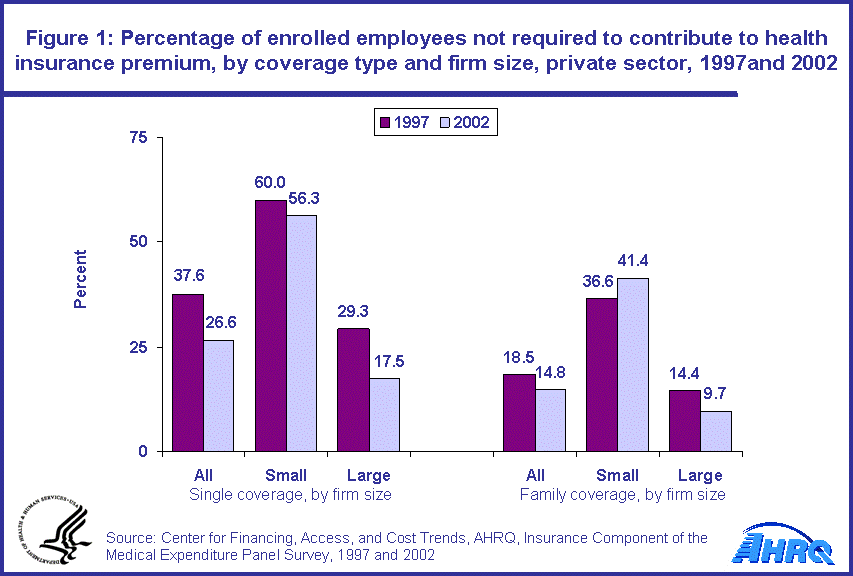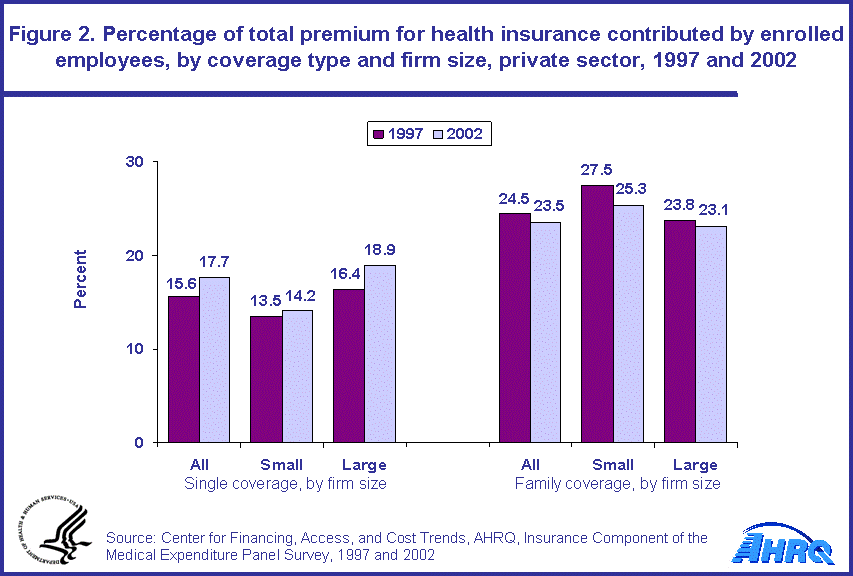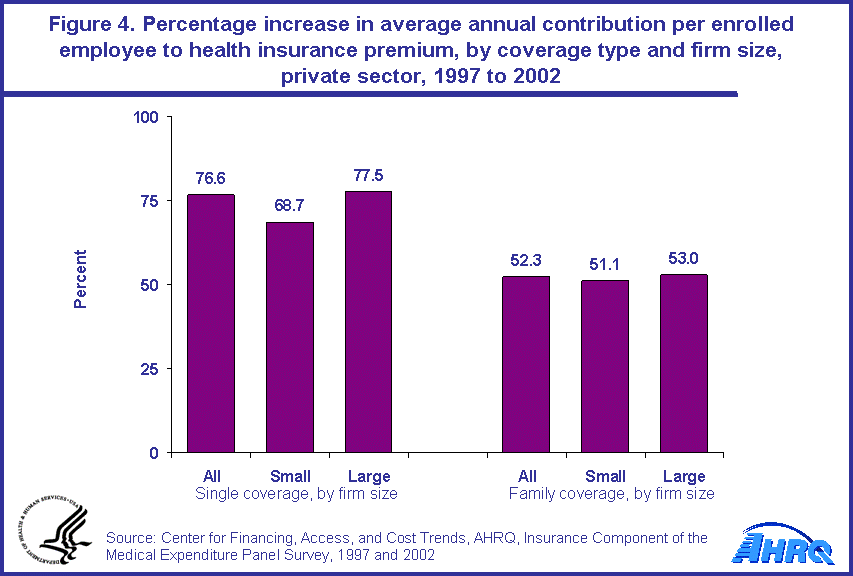
|
|
Font Size:
|
||||
|
|
|
|
||||
STATISTICAL BRIEF #55:
Employee Contributions to Employer-Sponsored Health Insurance Coverage, 1997 versus 2002
Highlights
- The portion of private sector employees enrolled in single coverage health insurance plans who did not contribute to the plan premium fell from 37.6 percent in 1997 to 26.6 percent in 2002.
- There was also a decline for those enrolled in family coverage; 18.5 percent of employees enrolled in family plans made no contribution to their premium in 1997 versus 14.8 percent in 2002.
- Among enrolled employees (which includes those contributing to their premium and those not contributing), the percentage of the total single premium they contributed rose from 15.6 percent in 1997 to 17.7 percent in 2002. Conversely, however, the percentage contributed overall toward the premium by those enrolled in family plans did not change significantly over the five-year period.
- Actual dollar employee contributions were up across the board between 1997 and 2002, with dollar contributions rising about four to six times faster than the overall inflation rate.
Introduction
Firms that offer health insurance coverage to their employees vary in the degree to which they subsidize that coverage. Employees who obtain employer-sponsored insurance may be required to contribute nothing toward the premium cost, pay the entire premium, or share the cost with the firm. This Statistical Brief, based on estimates from the Insurance Component of the Medical Expenditure Panel Survey (MEPS-IC), shows the changes in employee contributions for both single and family (for a family of four) coverage from 1997 to 2002 in the private sector of the economy. Changes for employees working for small (fewer than 50 employees) and large (50 employees or more) firms are analyzed. All differences between estimates discussed in the text are statistically significant at the 0.05 level.
Findings
Overall, the portion of private sector employees enrolled in single coverage health insurance plans who did not contribute to the plan premium fell from 37.6 percent in 1997 to 26.6 percent in 2002 (figure 1). There was also a decline for those enrolled in family coverage; the percentage of employees enrolled in family coverage who did not contribute to the plan premium dropped from 18.5 percent in 1997 to 14.8 percent in 2002.
Large firms, which employ about 72 percent of private sector workers (data not shown), had a much larger drop in the portion of employees not contributing to single coverage, from 29.3 percent in 1997 to 17.5 percent in 2002, than small firms, from 60.0 percent in 1997 to 56.3 percent in 2002.
For employees of small firms, the percentage with a family plan who did not contribute to their premium actually rose from 1997 (36.6 percent) to 2002 (41.4 percent), in contrast to the overall trend. In large firms, the portion of employees with a family plan who did not contribute fell from 14.4 percent in 1997 to 9.7 percent in 2002.
Among enrolled employees (which includes those contributing to their premium and those not contributing), the percentage of the total single premium they contributed rose from 15.6 percent in 1997 to 17.7 percent in 2002 (figure 2). Conversely, however, the percentage contributed overall toward the premium by those enrolled in family plans did not change significantly over the five-year period. Employees of large private sector firms paid a larger portion of their single premium in 2002 than in 1997; the percentage for small firms was basically unchanged over the period. For family coverage, while the employees of small firms paid a smaller portion of their premium in 2002 than in 1997, the portion paid in large firms did not vary.
Although the change in the percentage that employees contributed toward premiums varied by coverage type and firm size over the period, actual dollar employee contributions were up across the board. Dollar increases rose about four to six times faster than the overall inflation rate of 12.1 percent from 1997 to 2002, as measured by the Bureau of Labor Statistics' Consumer Price Index for All Urban Consumers. For example, the average annual contribution for enrolled employees with single coverage in 2002 was $565, up nearly 77 percent from $320 in 1997 (figures 3 and 4). The average annual contribution for family plans rose 52.3 percent, from $1,305 in 1997 to $1,987 in 2002. In small firms, the average dollar contribution increased 68.7 percent for single coverage and 51.1 percent for family coverage over the five-year period. Large firms showed a jump of 77.5 percent in the average single contribution and 53.0 percent in the average family contribution.
From 1997 to 2002, the annual contribution for single coverage for the average paying enrollee (which excludes those making no contribution) in the private sector was up 50.1 percent to $770. Family plan annual contributions for the average paying enrollee increased 45.7 percent to $2,332 in 2002. (Data not shown.)
Data Source
The statistics in this brief are from the 1997 and 2002 MEPS-IC. All information comes from tables available on the MEPS Web site (http://www.meps.ahrq.gov).
Definitions
Employer
A particular workplace or physical location where business is conducted or services or industrial operations are performed. In this brief, only private sector employer data are reported.
Employee
A person on the actual payroll. This excludes temporary and contract workers but includes the owner or manager if that person works at the firm.
Enrollee
An employee who is enrolled in a health insurance plan offered by the employer. Enrollees do not include any dependents covered by the plan.
Firm
A business entity comprising one or more business establishments under common ownership or control. A firm represents the entire organization, including the company headquarters and all divisions, subsidiaries, and branches. A firm may consist of a single-location establishment, in which case the establishment and firm are identical. A small firm has fewer than 50 employees; a large firm has 50 or more employees.
Health insurance plan
An insurance contract that provides hospital and/or physician coverage to an employee for an agreed-upon fee for a defined benefit period, usually a year.
Premium
Agreed-upon fees paid for coverage of medical benefits for a defined benefit period. Premiums can be paid by employers, unions, employees, or shared by the insured individual and the plan sponsor.
Single coverage
Health insurance that covers the employee only.
Family coverage
Health insurance that covers the employee and the employee's family. If a plan offers more than one pricing level for family coverage, information for a family of four was reported.
About MEPS-IC
MEPS-IC is a survey of business establishments and governments that collects information on employer-sponsored health insurance, such as whether insurance is offered, enrollments, types of plans, and premiums. The survey is conducted annually by the U.S. Bureau of the Census under the sponsorship of the Agency for Healthcare Research and Quality. The yearly response rate has averaged 78 percent for in-scope sample units. Approximately 4 percent of the original sample has been out-of-scope in a typical year.
For more information on this survey, see MEPS Methodology Reports 6, 8, and 10 under MEPS publications at http://www.meps.ahrq.gov/mepsweb/data_stats/publications.jsp and the MEPS-IC Technical Appendix at http://www.meps.ahrq.gov/mepsweb/survey_comp/ic_technical_notes.shtml.
Suggested Citation
Crimmel, B.L. Employee Contributions to Employer-Sponsored Health Insurance Coverage, 1997 versus 2002. Statistical Brief #55. September 2004. Agency for Healthcare Research and Quality, Rockville, MD. http://www.meps.ahrq.gov/mepsweb/data_files/publications/st55/stat55.shtml
 |
|||||||||||||||||||||||||||||||||||
|
|||||||||||||||||||||||||||||||||||
|
|
|||||||||||||||||||||||||||||||||||
 |
|||||||||||||||||||||||||||||||||||
|
|||||||||||||||||||||||||||||||||||
|
|
|||||||||||||||||||||||||||||||||||
 |
|||||||||||||||||||||||||||||||||||
|
|||||||||||||||||||||||||||||||||||
|
|
|||||||||||||||||||||||||||||||||||
 |
|||||||||||||||||||||||||||||||||||
|
|||||||||||||||||||||||||||||||||||
|
|
|||||||||||||||||||||||||||||||||||


